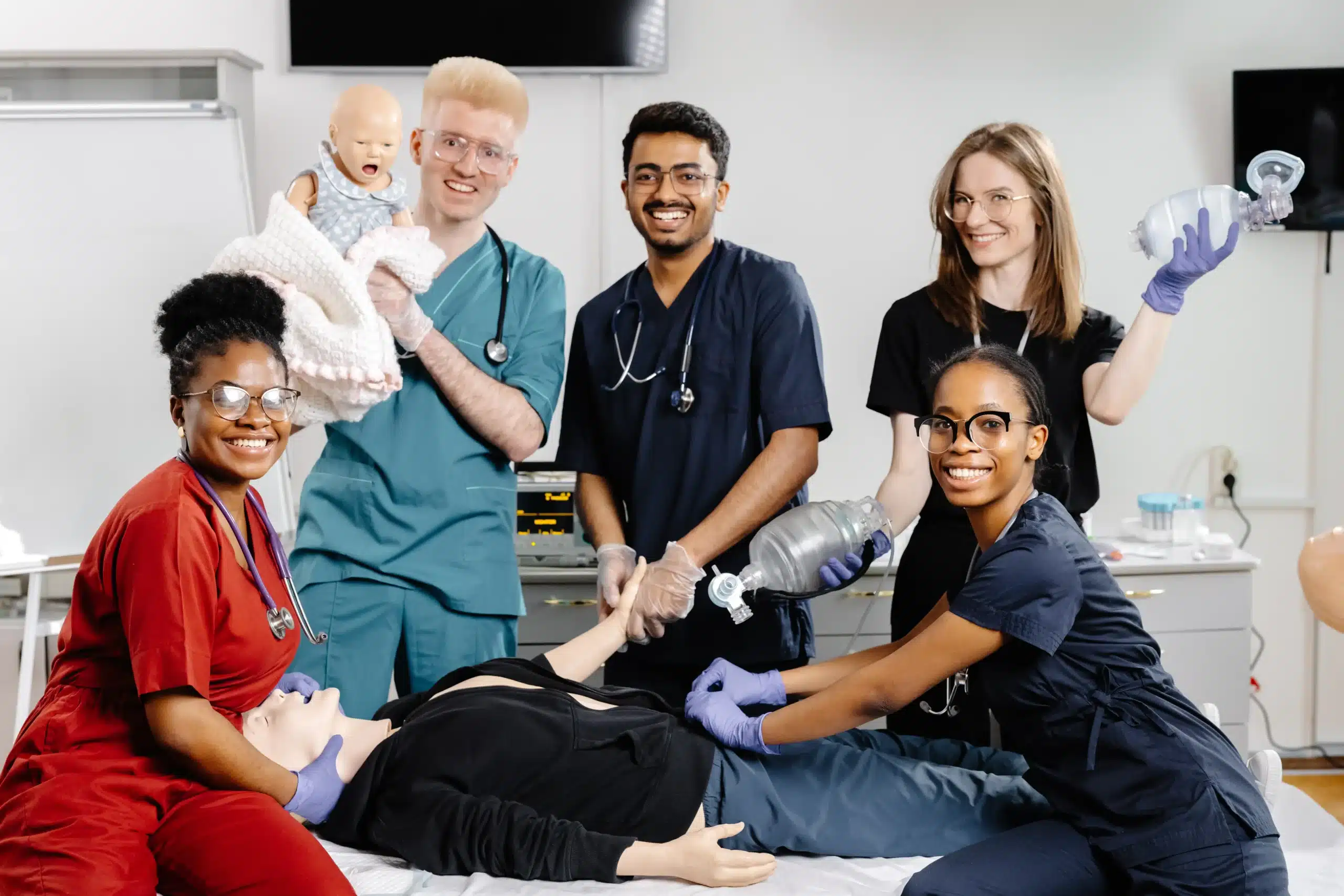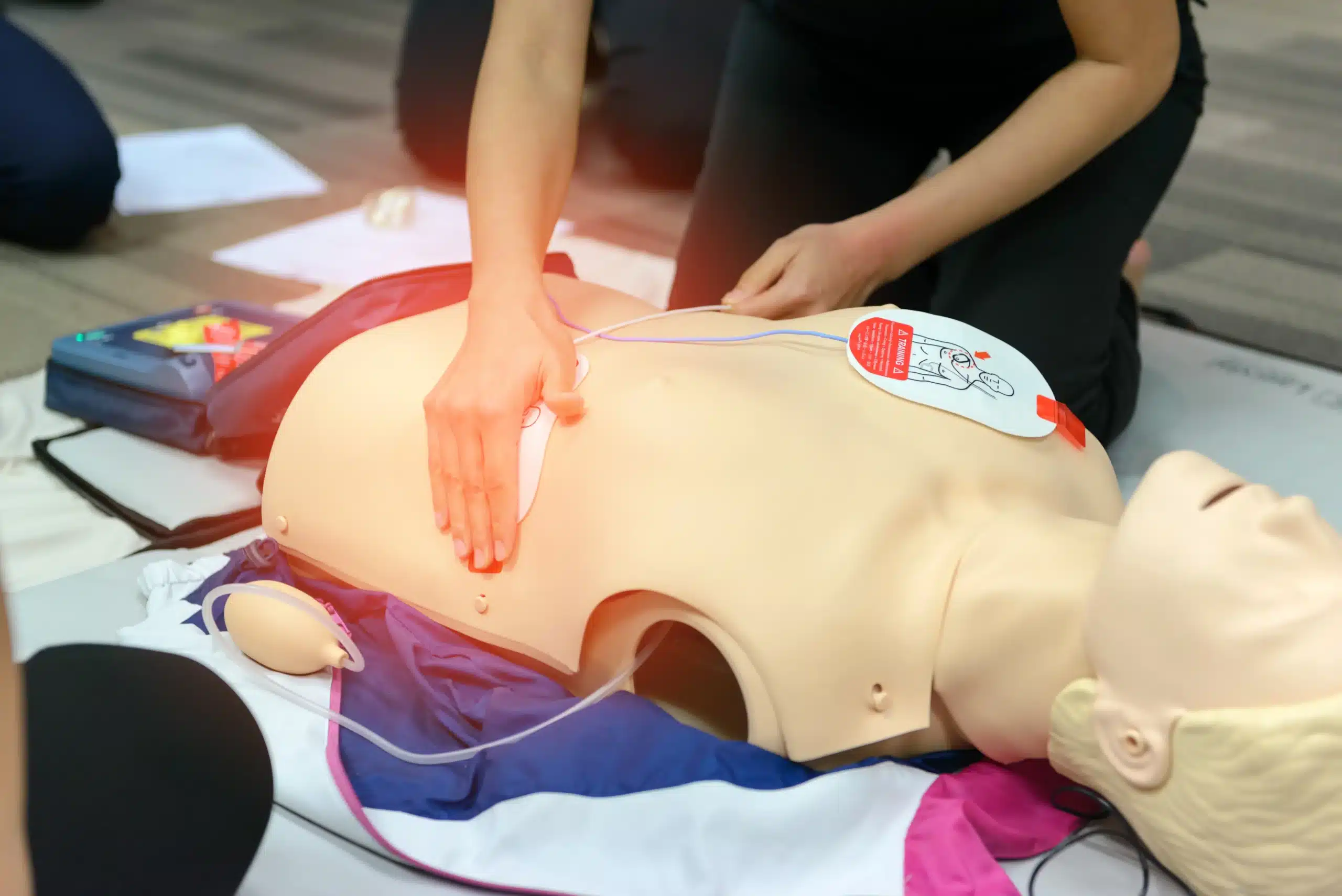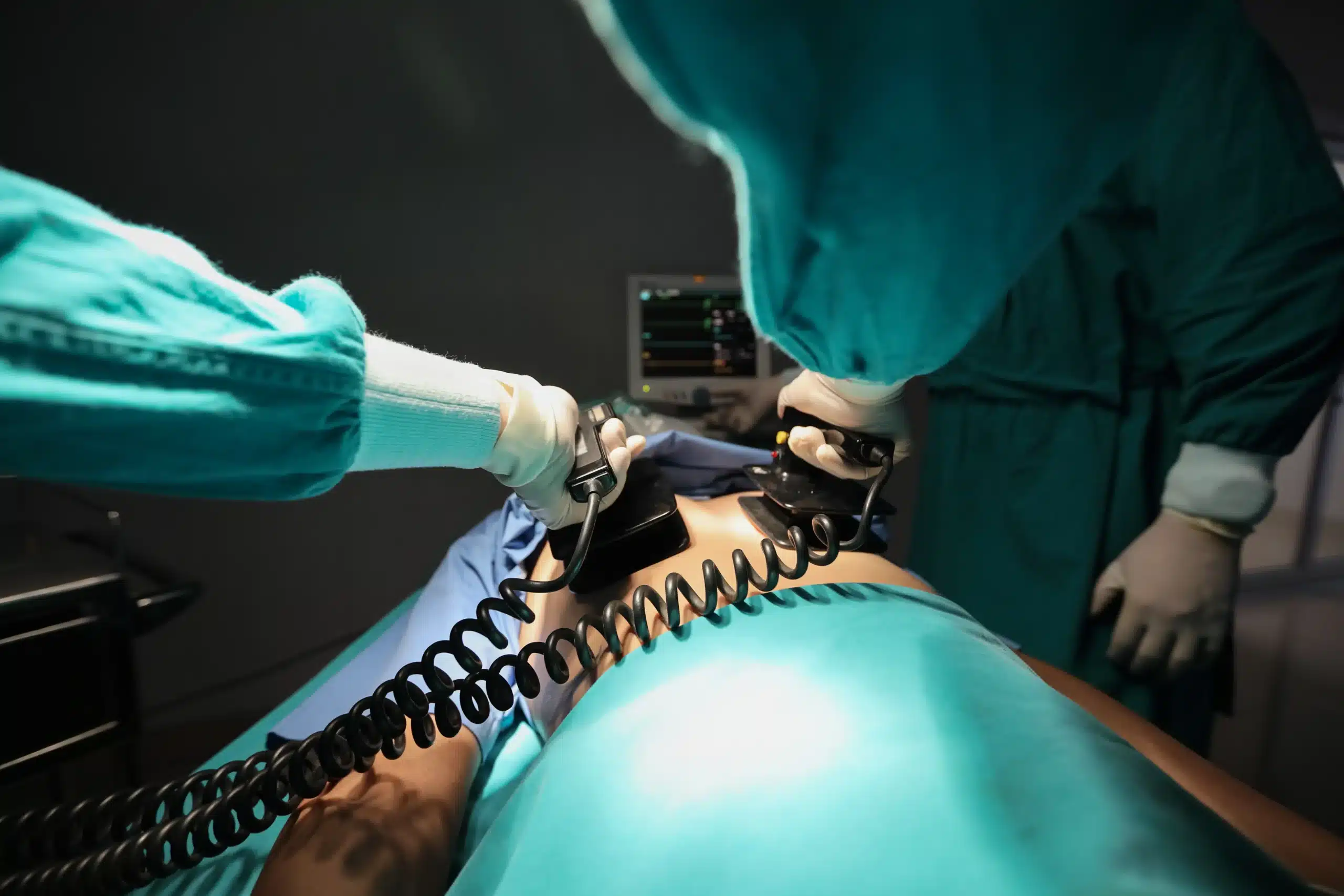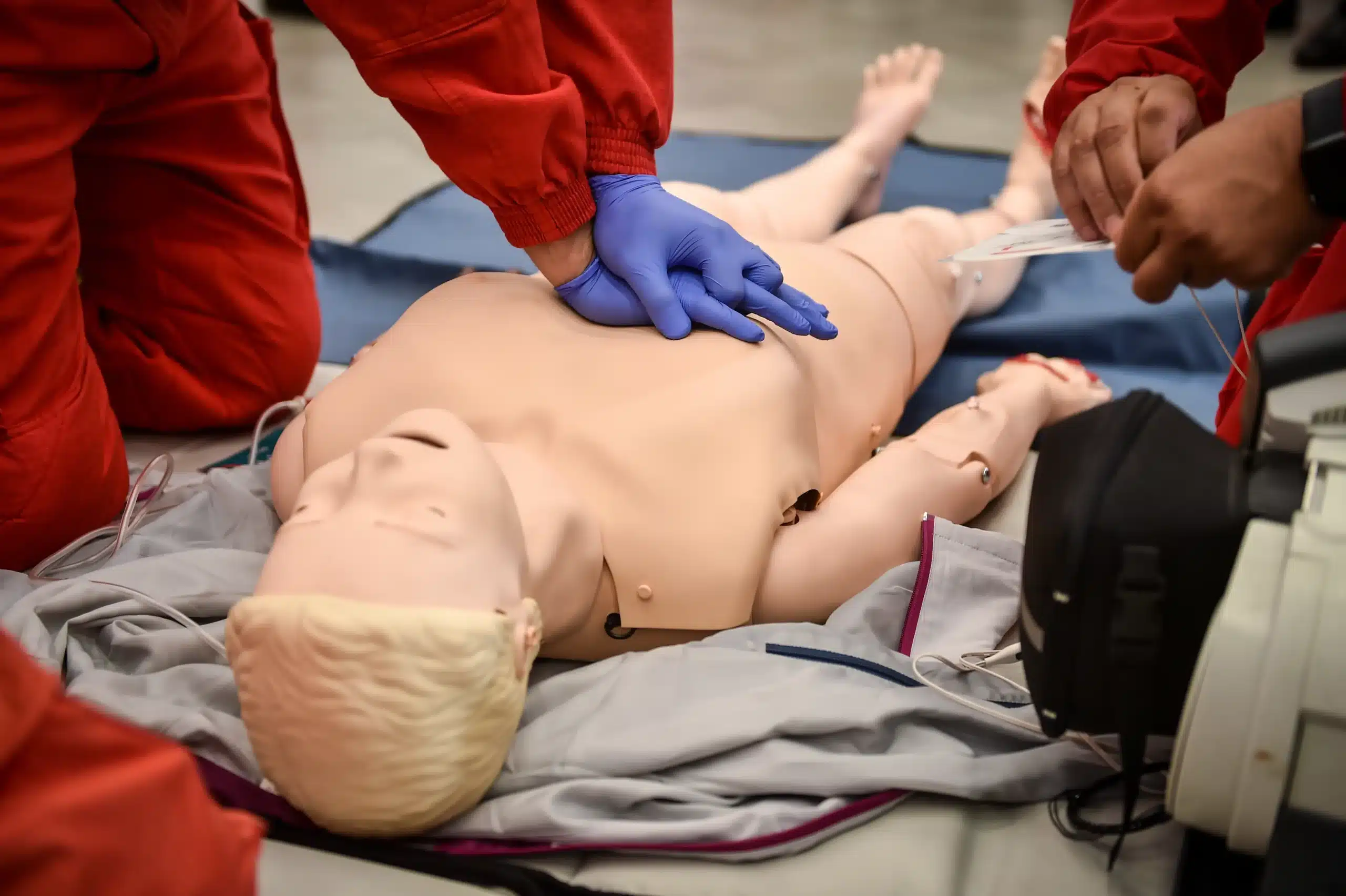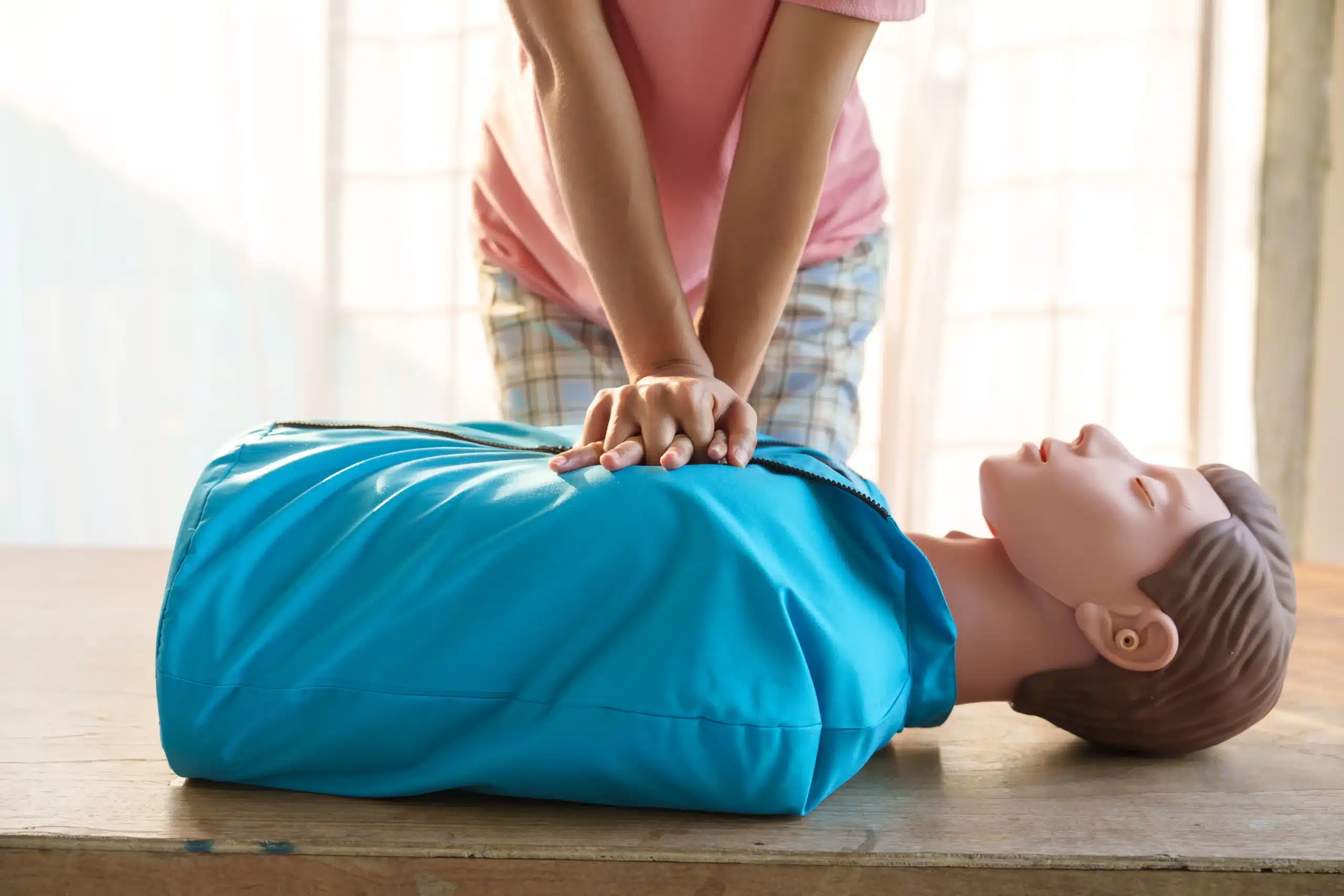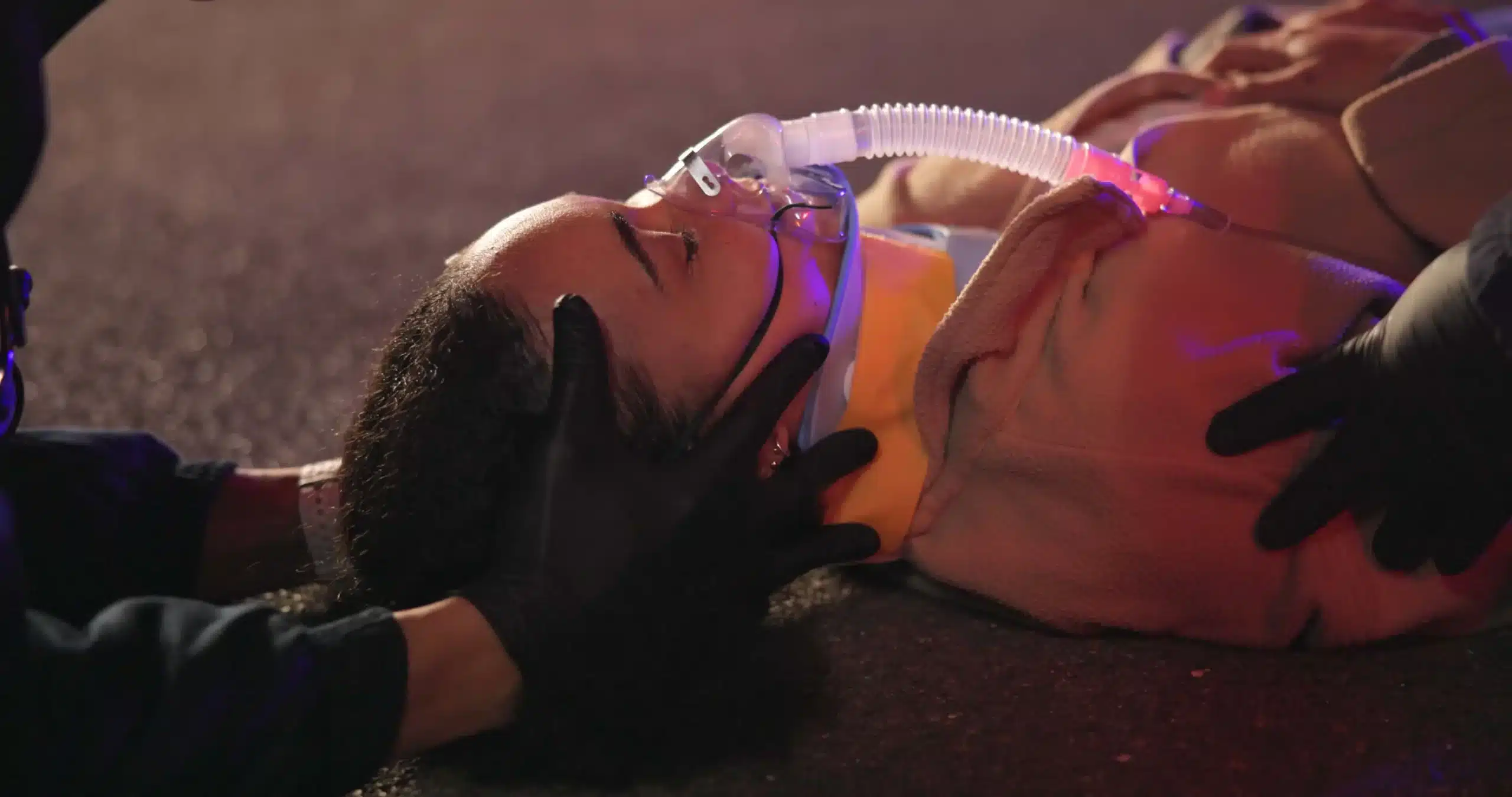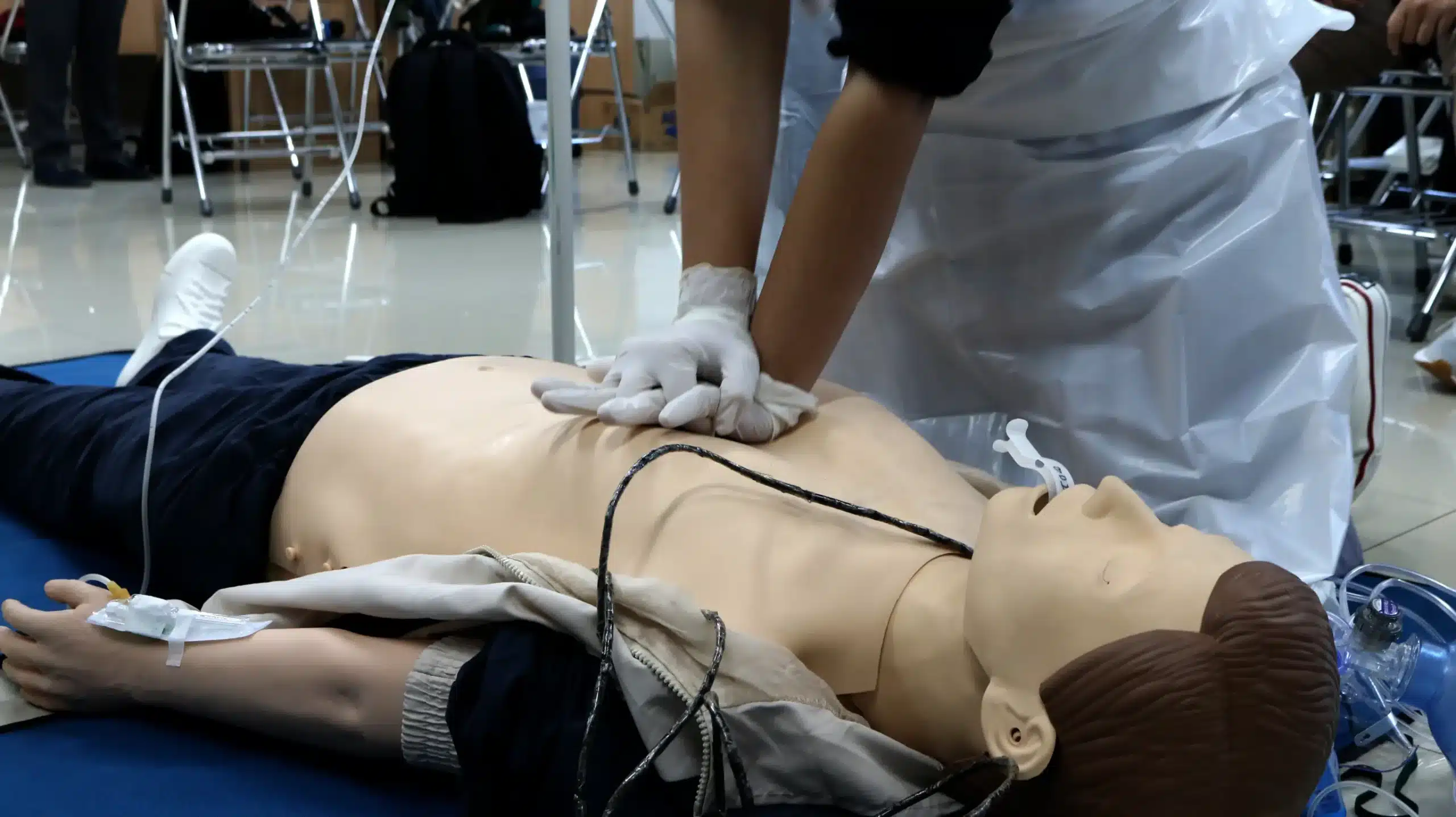As a healthcare provider, you know that seconds count during a medical emergency. Having the right skills can literally mean the difference between life and death. That’s why American Heart BLS (Basic Life Support) certification is so vital. It’s the foundation for providing high-quality CPR and other essential cardiovascular life support skills. This guide walks you through everything you need to know about BLS certification—from understanding the core components and course content to navigating the certification process and finding the right course near you. We’ll also discuss the costs involved, renewal procedures, and why AHA BLS is the gold standard for healthcare professionals.
Key Takeaways
- AHA BLS certification equips you with essential skills like CPR and AED use, crucial for healthcare professionals and valuable for anyone. Choose a learning format—in-person, blended, or online—that suits your needs and preferences.
- Earning your AHA BLS certification involves completing a course, passing exams, and renewing every two years. Stay current with the latest AHA guidelines and utilize available resources to confidently master these life-saving skills.
- Find convenient and affordable AHA BLS courses at Safety Training Seminars in San Jose, Santa Clara, and Sunnyvale. They offer various courses, including BLS, ACLS, PALS, and RQI, with a low price guarantee.
What is AHA BLS Certification?
The American Heart Association (AHA) Basic Life Support (BLS) Provider Certification program equips healthcare professionals and other rescuers with the skills to recognize and respond to life-threatening emergencies. It’s the gold standard for basic life support training, focusing on high-quality CPR and other essential cardiovascular life support skills. This certification is vital for anyone working in healthcare and valuable for anyone who wants to be prepared to help in a crisis. Learn more about our BLS certification courses in San Jose.
Key BLS Components
BLS certification covers several key areas, including CPR, using an Automated External Defibrillator (AED), and basic airway management. The training stresses the importance of providing immediate support, like ensuring open airways and performing rescue breathing or CPR, until more advanced medical help arrives. These skills are fundamental for responding effectively to cardiac arrest, respiratory distress, and other emergencies. We offer a variety of BLS courses in San Jose to fit your schedule.
Why BLS Matters for Healthcare Professionals and Everyone
BLS certification is essential for healthcare providers. It ensures they can deliver immediate, high-quality care during emergencies, directly impacting patient outcomes. Beyond the clinical setting, BLS skills empower anyone to respond confidently to life-threatening situations. Knowing how to perform CPR and use an AED can dramatically increase the chances of survival for someone experiencing cardiac arrest. Even if you’re not a healthcare professional, consider getting BLS certified; it could save a life. Our low price guarantee makes this life-saving training accessible. For healthcare professionals needing to renew their certification, our convenient RQI program offers a flexible option.
AHA BLS Courses & Materials
The right BLS course format depends on your learning style and schedule. The American Heart Association offers a few different options to prepare you for your BLS Provider Certification exam.
In-Person Classes
Traditional in-person BLS classes provide a structured learning environment with face-to-face interaction with an AHA Instructor. These classes offer hands-on training and allow you to ask questions and practice skills in real-time. This format is ideal for those who thrive in a classroom setting and value direct feedback. You can find BLS courses in San Jose at our Willow Glen location. In-person training ensures you receive personalized instruction and can address any concerns immediately. For more information on the AHA BLS program, check out our BLS page.
Online (HeartCode BLS)
For those who prefer self-paced learning or have scheduling constraints, the HeartCode BLS online course is an excellent option. This self-directed program allows you to complete the cognitive portion of the course online at your own speed. HeartCode BLS combines online modules with interactive simulations, providing flexibility and convenience. After completing the online portion, you’ll schedule a hands-on skills session with an AHA Instructor to demonstrate competency.
Blended Learning
Blended learning combines the best of both worlds. This format allows you to complete the cognitive portion of the course online through HeartCode BLS, followed by an abbreviated in-person skills session. Blended learning offers flexibility while still providing essential hands-on practice and instructor feedback. The AHA’s BLS Course is designed for healthcare professionals and other personnel who need to perform CPR and other basic cardiovascular life support skills.
Study Materials
Regardless of the course format you choose, access to high-quality study materials is essential for success. BLS certification training typically includes resources like the BLS Provider Manual, which covers essential topics such as CPR, AED usage, and airway management. Many courses also provide access to online resources, practice tests, and videos to reinforce learning. Review the materials thoroughly and take advantage of any available practice opportunities to build your confidence and prepare for the certification exam.
BLS Course Content & Skills
BLS certification equips you with the skills to respond confidently during emergencies. This section breaks down the core components you’ll cover in a BLS course.
High-Quality CPR
High-quality CPR is the cornerstone of BLS. You’ll learn the proper techniques for chest compressions, rescue breaths, and how to recognize the signs of a cardiac arrest. The training emphasizes the importance of providing supportive care, including maintaining airway patency and performing rescue breathing or CPR as needed until professional help arrives. This includes understanding how to use an AED (Automated External Defibrillator). For more information on BLS courses in San Jose, check out our BLS course page.
AED Use & Care
AEDs are life-saving devices, and BLS training teaches you how to operate them effectively. You’ll learn to assess the situation, safely apply the AED pads, and follow the device’s prompts. The course also covers AED maintenance and troubleshooting common issues. The American Heart Association’s BLS Course provides more information on these essential skills.
Choking Response (Adults, Children, Infants)
Choking emergencies require a swift and appropriate response. BLS training covers how to recognize choking signs and perform the Heimlich maneuver on adults, children, and infants. You’ll practice these techniques in a safe environment to build your confidence and proficiency. The course covers standard resuscitation techniques for adult, child, and infant care. For those working with children, our EMSA Health and Safety course offers additional relevant training.
Teamwork in Emergencies
Effective teamwork is crucial during medical emergencies. BLS training emphasizes communication, coordination, and clear roles within a response team. You’ll participate in simulated scenarios to practice these skills and learn how to work efficiently under pressure. Team-based resuscitation simulations are a key part of the training, promoting competence in team dynamics and increasing students’ self-efficacy for participating in real hospital-based resuscitations. We offer a low price guarantee on all our courses.
Getting AHA BLS Certified
So, you’re ready to become BLS certified? Great! This section covers what to expect during the certification process. We’ll break down the course structure, how to pass the exam, and what’s involved in keeping your certification current.
Course Structure & Duration
The AHA BLS course covers core life-saving skills for healthcare providers and other qualified rescuers. It emphasizes early recognition of and response to life-threatening emergencies like cardiac arrest, stroke, and choking. You’ll learn how to perform high-quality CPR for adults, children, and infants, use an AED (automated external defibrillator), and provide effective relief for choking victims. The course also stresses the importance of teamwork and communication during emergencies. BLS courses typically take a few hours to complete, depending on the format you choose (in-person, blended learning, or online). Check out our available BLS courses in San Jose to see what works best for your schedule. We also offer training for childcare providers in California covering health, safety, and lead poisoning.
Exams & Passing
To earn your AHA BLS Provider Certification, you’ll need to successfully complete both a written exam and a skills test. The written exam assesses your understanding of the BLS concepts and protocols. The skills test evaluates your ability to perform CPR and other life-saving techniques correctly. Don’t worry, your instructor will guide you through the process and provide feedback to help you master these essential skills. Once you pass both the written and skills tests, you’ll receive your official AHA BLS Provider Course Completion Card, valid for two years. More information on the AHA BLS course and certification can be found on the American Heart Association website.
Certification Renewal
Your BLS certification is valid for two years. To maintain your credentials and stay up-to-date with the latest AHA guidelines, you’ll need to renew your certification before it expires. Renewal involves taking another BLS course and passing the required exams. This ensures that you maintain the skills and knowledge necessary to provide effective care in emergency situations. Many healthcare professionals find that BLS renewal courses also offer continuing education credits, which can be valuable for career advancement. Check out our convenient and flexible RQI program to renew your BLS certification. We also offer a low price guarantee, so you can be confident you’re getting the best value for your training.
AHA BLS Costs
Getting your BLS certification is an investment in your skills and ability to respond to emergencies. Understanding the associated costs will help you budget and plan accordingly.
Course Fees & Packages
BLS course fees vary based on location, training center, and the format you choose (in-person, blended learning, or online). Expect fees in the range of $65 to $90. Some training centers, like Safety Training Seminars, offer package deals that combine BLS certification with other courses like ACLS or PALS, often at a discounted rate. Check with your chosen provider for their specific pricing structure. You can find our course schedule and pricing for BLS courses in San Jose right here on our website.
Discounts & Promotions
Many training centers offer discounts for students, military personnel, first responders, or group bookings. Keep an eye out for promotional offers. Some providers also offer discounts if you register for multiple courses at once. Be sure to ask about potential discounts when you inquire about a course. Safety Training Seminars offers a low price guarantee, so you can be confident you’re getting the best value.
ROI for Healthcare Professionals
For healthcare professionals, BLS certification is a necessity. It’s an investment in your career. A BLS certification demonstrates your commitment to patient safety and high-quality care. Many healthcare jobs require current BLS certification as a condition of employment. Beyond the professional advantages, the skills you gain can make a real difference in life-or-death situations. Consider the value of the knowledge and confidence you’ll gain. You can learn more about our RQI program, a specialized resuscitation quality improvement program designed for healthcare professionals. We also offer EMSA Health and Safety training required for childcare providers in California.
AHA BLS vs. Other Certifications
Choosing the right BLS certification can feel overwhelming with so many options available. This section clarifies the key differences between certifications from the American Heart Association (AHA) and other providers like the Red Cross, National CPR Foundation, and ProTrainings. Understanding these distinctions helps you make an informed decision for your career and personal goals.
AHA vs. Red Cross, National CPR Foundation, ProTrainings
While various organizations offer BLS certification, the AHA is widely recognized as the gold standard, especially for healthcare providers. Let’s break down how these organizations compare:
-
American Heart Association (AHA): The AHA focuses heavily on evidence-based research and science, regularly updating their guidelines to reflect the latest advancements in resuscitation science. This commitment to staying current makes AHA certification highly respected in the medical community. AHA courses emphasize high-quality CPR, teamwork, and effective use of an AED.
-
Red Cross: The Red Cross BLS course also meets requirements for healthcare professionals and other fields. It covers similar core skills as the AHA course, including CPR, AED use, and choking relief.
-
National CPR Foundation: The National CPR Foundation offers a range of courses, including BLS, often appreciated for their flexibility and online accessibility. This can be a convenient option for those with busy schedules or limited access to in-person training.
-
ProTrainings: ProTrainings provides another online BLS certification option known for its interactive content and user-friendly platform. This can be a good choice for self-paced learning.
Industry Acceptance
While several BLS certifications exist, the AHA certification is generally preferred and often required within hospital settings and by many healthcare employers. This preference stems from the AHA’s rigorous, science-backed approach and its reputation as a leader in cardiovascular care.
Research shows that most out-of-hospital cardiac arrests treated by emergency medical services involve advanced life support (ALS). However, the evidence supporting ALS over BLS is limited, highlighting the continued importance of high-quality BLS skills, regardless of the work setting. Whether you’re a healthcare professional or a concerned citizen, having a solid foundation in BLS is invaluable.
Choosing Your AHA BLS Course
Finding the right AHA BLS course involves understanding your needs and learning style. This section breaks down the key factors to consider when making your decision.
Factors to Consider
First, think about who you are and what you do. The AHA’s BLS Course is designed for healthcare professionals, but it’s also valuable for anyone who wants to be prepared for emergencies. Consider your current role and whether BLS certification is a job requirement or a personal goal. This will help you narrow your search. Another important factor is the validity of the certification. Make sure any course you choose aligns with the latest AHA guidelines so your certification is recognized and up-to-date. Finally, check if your workplace or any organizations you’re affiliated with require a specific type of BLS course or provider. For childcare providers in California, check out our EMSA Health, Safety, and Lead Poisoning training.
Matching Learning Styles & Course Formats
One of the best things about BLS certification is the flexibility in how you learn. Online BLS courses offer a convenient way to learn at your own pace, especially for busy professionals. However, some people prefer the hands-on experience and direct interaction of an in-person class. Blended learning, which combines online modules with in-person skills sessions, offers a balance between the two. The AHA supports various learning methods, including self-directed learning and the use of feedback devices, to improve CPR performance. Think about what works best for you—whether you thrive in a classroom setting or prefer the autonomy of online learning—and choose a course format that matches your preferences. If you learn best by doing, an in-person or blended learning course might be a better fit. If you need more flexibility, an online course could be ideal. Our BLS courses in San Jose offer various formats to suit different learning styles, and our low price guarantee ensures you’re getting the best value.
Prepare for AHA BLS Certification
Getting ready for your AHA BLS certification involves more than just showing up. A little prep work goes a long way toward ensuring you’re confident and ready to succeed. Here’s how to approach studying and practice:
Effective Study Strategies
Start by reviewing the official AHA BLS Provider Manual. Familiarize yourself with the core concepts and procedures before class. Even if you’ve taken a CPR course before, guidelines change, so always use the most current resources. The 2020 American Heart Association Guidelines for Cardiopulmonary Resuscitation and Emergency Cardiovascular Care emphasize self-directed learning and the use of feedback devices, especially for AED proficiency, as highlighted in this research. Take practice quizzes online or create flashcards to test your knowledge.
Hands-On Practice
BLS is a hands-on skill, so practice is essential. If your course offers practice sessions or simulations, take full advantage of them. Studies, like this one on high-fidelity simulation, show that simulations can significantly improve team-based resuscitation skills. Even practicing on a CPR manikin at home can improve your technique and build muscle memory. Consider incorporating real-time feedback, as this research00264-5/fulltext) suggests it optimizes CPR skill acquisition.
Common Challenges & Solutions
One common concern is the cost of BLS certification. Check with your employer—some organizations cover the cost of training, especially for healthcare providers. Look for discounts or group rates, which can make the training more affordable. Remember, BLS certification comes with continuing education credits, which can be valuable for professional development. If you’re simply renewing your certification, a streamlined recertification course can save you time. Don’t let these common hurdles stop you from gaining this life-saving skill.
Maintain Your AHA BLS Certification
Once you’ve earned your AHA BLS certification, staying current is key. Knowing the latest techniques can make all the difference in an emergency. Here’s what you need to know about maintaining your certification:
Renewing Your Certification
AHA BLS certification is valid for two years. To keep your skills sharp and your certification current, you’ll need to renew your BLS certification before it expires. This renewal process isn’t just about checking a box; it’s a chance to refresh your knowledge and learn any updated guidelines or techniques in basic life support. Think of it as a tune-up for your lifesaving skills. Check out our BLS courses in San Jose to easily recertify.
Continuing Education
For healthcare professionals, continuing education is essential for career growth and staying at the top of your field. Completing your BLS course provides continuing education credits. These credits can help you maintain other professional certifications and demonstrate your commitment to ongoing learning. Our RQI program is another convenient way to meet continuing education requirements.
Staying Up-to-Date with AHA Guidelines
The American Heart Association (AHA) regularly reviews and updates its guidelines based on the latest scientific research and best practices in cardiovascular care. Staying informed about these updates is crucial for providing the most effective care. The AHA’s BLS Course ensures you’re equipped with the most current knowledge and techniques to handle emergencies confidently. Regularly reviewing the AHA website and resources will help you stay informed about any changes and ensure you’re always prepared. For other essential certifications for California childcare providers, see our information on EMSA Health, Safety, and Lead Poisoning training. We also offer a low price guarantee, so you can be confident you’re getting the best value for your training.
Find AHA BLS Courses Near You
So, you’re ready to get your BLS certification—great! Now, it’s time to find the right course for you. Whether you prefer in-person learning or the flexibility of online courses, several options are available.
Authorized Training Centers
The American Heart Association (AHA) strongly recommends taking your BLS course through an authorized Training Center. These centers adhere to the AHA’s rigorous standards, ensuring you receive high-quality instruction and training materials. This is especially important for healthcare providers, as AHA certification is often a job requirement.
Online Course Providers
If a busy schedule makes attending in-person classes difficult, several online providers offer AHA BLS certification. Make sure the provider you choose is an official AHA Training Center or uses the official AHA HeartCode BLS program. Online BLS certification courses offer a convenient way to learn the material at your own pace and often incorporate interactive modules and simulations.
Safety Training Seminars (San Jose)
For those in and around San Jose, Safety Training Seminars offers a variety of BLS courses designed to meet the needs of healthcare professionals and other individuals seeking certification. With a focus on excellent customer service and a low price guarantee, Safety Training Seminars provides convenient in-person BLS training in San Jose, Santa Clara, and Sunnyvale. They also offer other essential courses like ACLS, PALS, and the RQI program. Check out their website to explore course options and find one that fits your needs. They even offer courses specifically for California childcare providers covering health, safety, and lead poisoning prevention.
Related Articles
- BLS Certification in Santa Clara: A Guide for Healthcare Providers – San Jose CPR Classes
- BLS Training Near Me: Your Complete Guide – San Jose CPR Classes
- BLS Training in San Jose: Your Ultimate Guide – San Jose CPR Classes
- BLS Renewal Near Me: Your Complete Guide – San Jose CPR Classes
- Find BLS Classes Near Me: Your Ultimate Guide – San Jose CPR Classes
Frequently Asked Questions
Is BLS certification required for my job?
BLS certification is often mandatory for healthcare professionals, including doctors, nurses, paramedics, and other roles involved in direct patient care. Even if not strictly required, holding a BLS certification can significantly enhance your job prospects and demonstrate your commitment to patient safety. Check with your employer or professional licensing board to confirm specific requirements for your field.
What’s the difference between online and in-person BLS courses?
Online BLS courses offer flexibility, allowing you to complete the coursework at your own pace. In-person classes provide a structured learning environment with direct interaction with an instructor and hands-on practice. Both formats typically include a skills test component where you demonstrate proficiency in CPR and other BLS techniques. Consider your learning style and schedule when choosing the best format for you.
How long does BLS certification last, and how do I renew it?
AHA BLS Provider certification is valid for two years. To renew, you must complete a recertification course before your current certification expires. Renewal courses cover the latest AHA guidelines and refresh your skills, ensuring you’re prepared to respond effectively in emergencies.
What if I don’t work in healthcare? Should I still get BLS certified?
Absolutely! While BLS certification is essential for healthcare providers, it’s a valuable skill for anyone to have. Knowing how to perform CPR and respond to emergencies can save lives, whether at home, in the workplace, or out in the community.
How much does a BLS course cost, and are there any discounts available?
BLS course fees vary depending on the training center, location, and course format. Many training centers offer discounts for students, military personnel, first responders, or group bookings. Some employers also cover the cost of BLS training for their employees. Inquire about potential discounts when you contact a training center.


